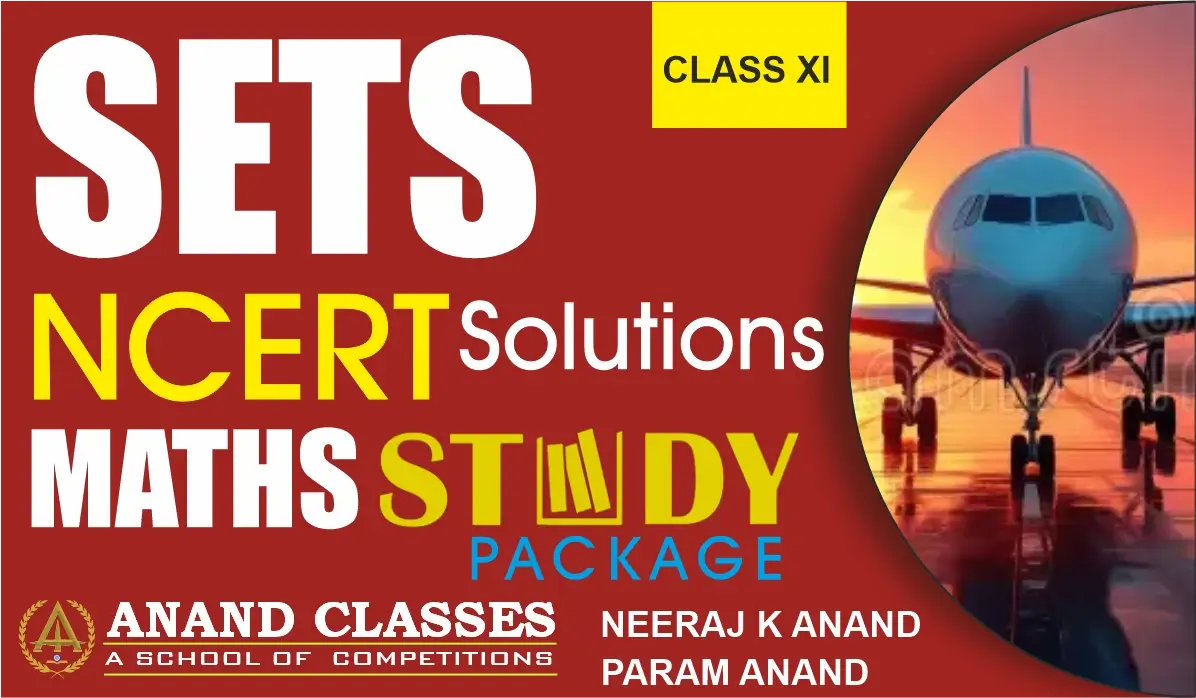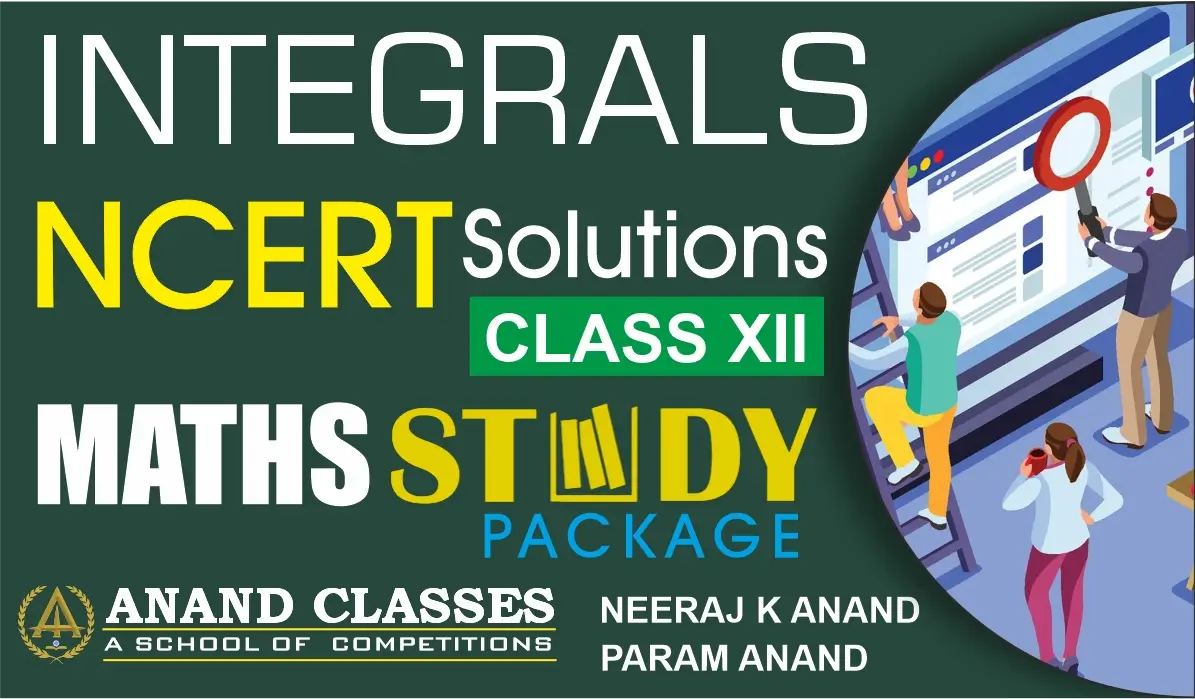Anand Classes offers accurate and well-explained Sets NCERT Solutions Exercise 1.1 Class 11 Maths to help students understand the basic concepts of sets easily and effectively. These step-by-step solutions strictly follow the latest NCERT and CBSE guidelines, ensuring conceptual clarity and exam readiness. Ideal for self-study and quick revision, these Class 11 Maths Chapter 1 Exercise 1.1 solutions make learning sets simple and structured. Click the print button to download study material and notes.
NCERT Question 1 : Which of the following are sets? Justify our answer
(i) The collection of all the months of a year beginning with the letter J.
(ii) The collection of ten most talented writers of India.
(iii) A team of eleven best-cricket batsmen of the world.
(iv) The collection of all boys in your class.
(v) The collection of all natural numbers less than 100.
(vi) A collection of novels written by the writer Munshi Prem Chand.
(vii) The collection of all even integers.
(viii) The collection of questions in this Chapter.
(ix) A collection of most dangerous animals of the world
Solution :
(i) The collection of all months of a year beginning with the letter J.
All months that begins with the letter J is a well-defined collection as one can easily identify whether a month begins with J or not.
Therefore, this collection is a set.
Useful NCERT revision notes for clear concept building by Anand Classes.
(ii) The collection of ten most talented writers of India.
Ten most talented writers of India is not a well-defined collection as one writer’s talent cannot be measured and it vary for person to person.
Therefore, this collection is not a set.
Clear NCERT-style explanations for confident exam preparation.
(iii) A team of eleven best-cricket batsmen of the world.
A team of eleven best cricket batsmen of the world is not a well-defined collection because one person can consider a batsman as best whereas other person may not consider it. There’s no measuring unit.
Therefore, this collection is not a set.
Concise NCERT-format practice to strengthen understanding by Anand Classes.
(iv) The collection of all boys in your class.
This collection is a well-defined collection as you can easily identify whether a boy belongs to your class or not.
Therefore, this collection is a set.
Handy NCERT notes for reliable classroom revision.
(v) The collection of all natural numbers less than 100.
The collection of all natural numbers less than $100$ is a well-defined collection because it’s possible to decide whether a number is less than $100$ or not.
Therefore, this collection is a set.
Compact NCERT-format solutions ideal for board exam practice.
(vi) A collection of novels written by the writer Munshi Prem Chand.
A collection of novels written by the writer “Munshi Prem Chand” is a well-defined collection because one can definitely identify whether a book is written by “Munshi Prem Chand” or not.
Therefore, this collection is a set.
Reliable NCERT-style content curated for study clarity.
(vii) The collection of all even integers.
This collection is a well-defined collection because one can definitely identify which is an even integer and which is not.
Therefore, this collection is a set.
Precise NCERT-format explanations to reinforce fundamentals.
(viii) The collection of questions in this Chapter.
This collection is a well-defined collection because one can definitely identify whether a question belongs to this chapter or not.
Therefore, this collection is a set.
Well-structured NCERT notes to aid quick revision.
(ix) A collection of most dangerous animals of the world.
This collection of most dangerous animals of the world is not a well-defined collection because the criteria for determining the dangerousness of an animal varies from person to person.
Therefore, this collection is not a set.
Exam-focused NCERT material for solid concept recall.
NCERT Question 2: Let $A = \{1, 2, 3, 4, 5, 6\}$. Insert the appropriate symbol $\in$ or $\notin$ in the blank spaces:
(i) $5\ \ldots\ A$
(ii) $8\ \ldots\ A$
(iii) $0\ \ldots\ A$
(iv) $4\ \ldots\ A$
(v) $2\ \ldots\ A$
(vi) $10\ \ldots\ A$
Solution:
(i) $5 \in A$
(ii) $8 \notin A$
(iii) $0 \notin A$
(iv) $4 \in A$
(v) $2 \in A$
(vi) $10 \notin A$
Perfectly formatted NCERT answers for quick practice and retention.
NCERT Question 3: Write the following sets in roster form:
(i) $A = {x: x \text{ is an integer and } -3 < x < 7}.$
(ii) $B = {x: x \text{ is a natural number less than }6}.$
(iii) $C = {x: x \text{ is a two-digit natural number such that the\\ sum of its digits is }8}$
(iv) $D = {x: x \text{ is a prime number which is divisor of }60}.$
(v) $E =$ The set of all letters in the word TRIGONOMETRY.
(vi) $F =$ The set of all letters in the word BETTER.
Solution:
(i)
$$A = \{-2,-1,0,1,2,3,4,5,6\}$$
(ii)
$$B = \{1,2,3,4,5\}$$
(iii)
$$C = \{80, 71 ,62, 53, 44, 26, 35, 17\}$$
(iv) Prime factorization of $60$ is
$$60 = 2^2 \times 3 \times 5$$
$$D = \{2 ,3 ,5\}$$
(v)
$$E = \{Y ,E ,M ,N ,O ,G ,I ,R ,T\}$$
(vi)
$$F = \{R ,T ,E ,B\}$$
Clear NCERT roster-form answers to build accuracy and speed.
NCERT Question 4: Write the following sets in the set-builder form:
(i) $\{3, 6, 9, 12\}$
(ii) $\{2, 4, 8, 16, 32\}$
(iii) $\{5, 25, 125, 625\}$
(iv) $\{2, 4, 6, ……\}$
(v) $\{1, 4, 9, …….,100\}$
Solution:
(i) $3=3\cdot1,\ 6=3\cdot2,\ 9=3\cdot3,\ 12=3\cdot4.$
$$\therefore\ \{3,6,9,12\}=\{x:\ x=3n,\ n\in\mathbb{N}\ \text{and}\ 1\le n\le 4\}$$
(ii) $2=2^1,\ 4=2^2,\ 8=2^3,\ 16=2^4,\ 32=2^5.$
$$\therefore\ \{2, 4, 8, 16, 32\}=\{x:\ x=2^n,\ n\in\mathbb{N}\ \text{and}\ 1\le n\le 5\}$$
(iii) $5=5^1,\ 25=5^2,\ 125=5^3,\ 625=5^4.$
$$\therefore\ \{5, 25, 125, 625\}=\{x:\ x=5^n,\ n\in\mathbb{N}\ \text{and}\ 1\le n\le 4\}$$
(iv) Given set is a set of all even natural numbers.
$$\therefore\ \{2, 4, 6,\dots\}=\{x:\ x \text{ is an even natural number\}}$$
(v) $1=1^2,\ 4=2^2,\ 9=3^2,\ \dots,\ 100=10^2.$
$$\therefore\ \{1, 4, 9,\dots,100\}=\{x:\ x=n^2,\ n\in\mathbb{N}\ \text{and}\ 1\le n\le 10\}$$
Concise NCERT set-builder forms for systematic learning.
NCERT Question 5: List all the elements of the following sets:
(i) $A = \{x: x \text{ is an odd natural number}\}$
(ii) $B = \{x: x \text{ is an integer, } -\tfrac{1}{2} < x < \tfrac{9}{2}\}$
(iii) $C =\{x: x \text{ is an integer, } x^2 \le 4\}$
(iv) $D = \{x: x \text{ is a letter in the word “LOYAL”}\}$
(v) $E = \{x: x \text{ is a month of a year not having }31\text{ days}\}$
(vi) $F =\{x: x \text{ is a consonant in the English alphabet \\which precedes }k\}$
Solution:
(i)
$$A = \{1, 3, 5, 7, 9,\dots\}$$
(ii) Integers satisfying $-\tfrac{1}{2}<x<\tfrac{9}{2}$ are $0,1, 2, 3, 4$
$$B = \{0, 1, 2, 3, 4\}$$
(iii) Check integers:
$$(-1)^2=1\le4,\quad (-2)^2=4\le4,\quad (-3)^2=9>4$$
$$0^2=0\le4,\quad 1^2=1\le4,\quad 2^2=4\le4,\quad 3^2=9>4$$
$$\therefore\ C = \{-2, -1, 0, 1, 2\}$$
(iv)
$$D = \{L, O, Y, A\}$$
(v)
$$E = \{\text{February, April, June, September, November}\}$$
(vi)
$$F = \{b, c, d, f, g, h, j\}$$
Targeted NCERT element lists to aid quick memorization.
NCERT Question 6: Match each of the set on the left in the roster form with the same set on the right described in set-builder form:
(i) $\{1, 2, 3, 6\}$
(a) $\{x:\ x \text{ is a prime number and a divisor of }6\}$
(ii) $\{2, 3\}$
(b) $\{x:\ x \text{ is an odd natural number less than }10\}$
(iii) $\{M, A,T, H,E, I, C, S\}$
(c) $\{x:\ x \text{ is natural number and divisor of }6\}$
(iv) $\{1, 3, 5, 7, 9\}$
(d) $\{x:\ x \text{ is a letter of the word MATHEMATICS}\}$
Solution:
(i) All the elements given in this set are natural numbers as well as the divisors of $6$.
Therefore, (i) matches with (c).
(ii) We know that $2$ and $3$ are prime numbers. They are also the divisors of $6$.
Therefore, (ii) matches with (a).
(iii) This set contains all the letters from the word MATHEMATICS.
Therefore, (iii) matches with (d).
(iv) This set contains odd natural numbers which are smaller than $10$.
Therefore, (iv) matches with (b).
Well-organized NCERT matching practice for quick assessment and revision.


